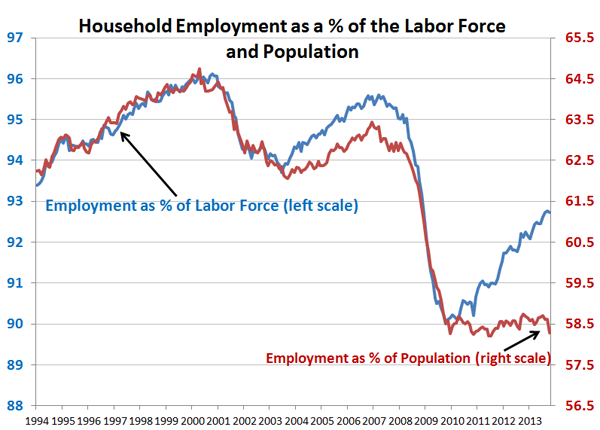Interest Rates and the Real Unemployment Rate
There’s nothing magic about a particular unemployment rate. No one number is enough to indicate that the economy is healthy.

Don’t be surprised if the U.S. unemployment rate hits 6.5% and the Federal Reserve still doesn’t start raising interest rates. Several Fed officials, including the current chairman, Ben Bernanke, and the incoming chairman, Janet Yellen, have suggested that a jobless rate that low would indicate that the economy was healthy enough to wean from today’s record-low interest rates. Months before it hit that level, the Fed would also have begun to taper off its massive bond buying campaign, gradually reversing its policy of quantitative easing. At its current pace of decline -- a 0.8 percentage point drop over eight months -- the unemployment rate would hit the presumed trigger at the end of 2014.
But the odds are it’ll be well into 2015 before the country’s monetary gurus are comfortable ratcheting up the federal funds rate—the rate at which banks borrow from one another or the Fed itself, effectively setting short-term rates for everyone. Why?
Because there’s a lot more to assessing the country’s unemployment situation than just the percentage of the labor force that is actively seeking a job but can’t find one. For starters, there’s the question of exactly who is in the labor force. The government’s definition—anyone who holds down a job or is actively seeking a job—ignores a sizable number of people. Every month, millions join the labor force: Young folks seeking their first jobs, new immigrants to the country, stay-at-home moms and dads who go back to work once their children reach school age and more. Nearly the same number drop out: New retirees, people who develop disabilities and can no longer work and, sadly, folks who want to work but have become so discouraged that they quit hunting for positions.
From just $107.88 $24.99 for Kiplinger Personal Finance
Become a smarter, better informed investor. Subscribe from just $107.88 $24.99, plus get up to 4 Special Issues

Sign up for Kiplinger’s Free Newsletters
Profit and prosper with the best of expert advice on investing, taxes, retirement, personal finance and more - straight to your e-mail.
Profit and prosper with the best of expert advice - straight to your e-mail.
Since the end of the recession in June 2009, the number of people leaving the labor force has climbed significantly. As a result, the labor force participation rate—the share of the total population that is either working or looking for a job—dropped from 65.7% to 63.2% in September 2013. (An upward blip in both the unemployment rate and the labor force participation rate in October was a distortion wrought by the partial government shutdown that month.)
At least four out of every 10 who dropped out of the labor force from June 2009 to September 2013 were jobless and likely too discouraged to keep looking for work. The largest decline in the labor force participation rate over that 51-month period was for males ages 25 to 29, clearly not retirees eager to spend their golden years on the golf course. Once these folks stop looking for work, the government figures they’re no longer in the labor force, so they’re no longer counted as involuntarily unemployed. And the unemployment rate goes down.
Fortunately, there are other ways to help gauge what’s really going on. Take a look at the chart below. It shows employment as a share of the labor force in blue. It’s essentially the unemployment rate upside down—a 7% unemployment rate means a 93% employment rate. As you might expect, the blue line drops during the recessions of 2001 and 2008-2009, and it rises after the recessions. The red line, which tracks employment as a share of the civilian population ages 16 and up is in sync with the blue line through the economic expansion of the 1990s and during the recession-spurred declines. But the two lines diverge in the periods that follow the recessions when people leave the labor force. The employed as a share of the labor force rises, but as a share of population, not so much. The flat trend since 2009 indicates that employment is keeping pace with population growth but isn’t recovering to its prerecession share.

If discouraged job seekers don’t come back into the labor force anytime soon, the Fed can treat a 6.5% jobless rate as a signal that recovery is assured and stop goosing the economy with easy money. But if some or all of the disaffected workers do start hunting for jobs again, the declining jobless rate will reverse course. And the wise men and women of the Federal Reserve know that. So they’re unlikely to start withdrawing monetary policy props for the economy too swiftly, perhaps waiting to see some upward movement in the red line. It will probably be 2015 before short-term interest rates begin to rise.
Profit and prosper with the best of Kiplinger's advice on investing, taxes, retirement, personal finance and much more. Delivered daily. Enter your email in the box and click Sign Me Up.

David is both staff economist and reporter for The Kiplinger Letter, overseeing Kiplinger forecasts for the U.S. and world economies. Previously, he was senior principal economist in the Center for Forecasting and Modeling at IHS/GlobalInsight, and an economist in the Chief Economist's Office of the U.S. Department of Commerce. David has co-written weekly reports on economic conditions since 1992, and has forecasted GDP and its components since 1995, beating the Blue Chip Indicators forecasts two-thirds of the time. David is a Certified Business Economist as recognized by the National Association for Business Economics. He has two master's degrees and is ABD in economics from the University of North Carolina at Chapel Hill.
-
 Stocks Chop as the Unemployment Rate Jumps: Stock Market Today
Stocks Chop as the Unemployment Rate Jumps: Stock Market TodayNovember job growth was stronger than expected, but sharp losses in October and a rising unemployment rate are worrying market participants.
-
 Should You Renew Your CD?
Should You Renew Your CD?With rate cuts impacting earnings, we examine if now is a wise time to renew CDs.
-
 7 Ways to Plan Now to Save on Medicare IRMAA Surcharges Later
7 Ways to Plan Now to Save on Medicare IRMAA Surcharges LaterUnderstand the critical two-year lookback period and why aggressive planning before you enroll in Medicare is the most effective way to minimize IRMAA.
-
 What to Expect from the Global Economy in 2026
What to Expect from the Global Economy in 2026The Kiplinger Letter Economic growth across the globe will be highly uneven, with some major economies accelerating while others hit the brakes.
-
 Amid Mounting Uncertainty: Five Forecasts About AI
Amid Mounting Uncertainty: Five Forecasts About AIThe Kiplinger Letter With the risk of overspending on AI data centers hotly debated, here are some forecasts about AI that we can make with some confidence.
-
 Worried About an AI Bubble? Here’s What You Need to Know
Worried About an AI Bubble? Here’s What You Need to KnowThe Kiplinger Letter Though AI is a transformative technology, it’s worth paying attention to the rising economic and financial risks. Here’s some guidance to navigate AI’s future.
-
 Will AI Videos Disrupt Social Media?
Will AI Videos Disrupt Social Media?The Kiplinger Letter With the introduction of OpenAI’s new AI social media app, Sora, the internet is about to be flooded with startling AI-generated videos.
-
 What Services Are Open During the Government Shutdown?
What Services Are Open During the Government Shutdown?The Kiplinger Letter As the shutdown drags on, many basic federal services will increasingly be affected.
-
 The Economy on a Knife's Edge
The Economy on a Knife's EdgeThe Letter GDP is growing, but employers have all but stopped hiring as they watch how the trade war plays out.
-
 Apple Readies for AI Upgrade with New iPhones
Apple Readies for AI Upgrade with New iPhonesThe Kiplinger Letter The tech giant has stumbled when it comes to artificial intelligence, but a new batch of iPhones will help it make headway.
-
 Japan Enters a New Era of Risk and Reform
Japan Enters a New Era of Risk and ReformThe Kiplinger Letter Japan has entered a pivotal moment in its economic history, undertaking ambitious policy and structural reforms to escape from decades of stagnation.